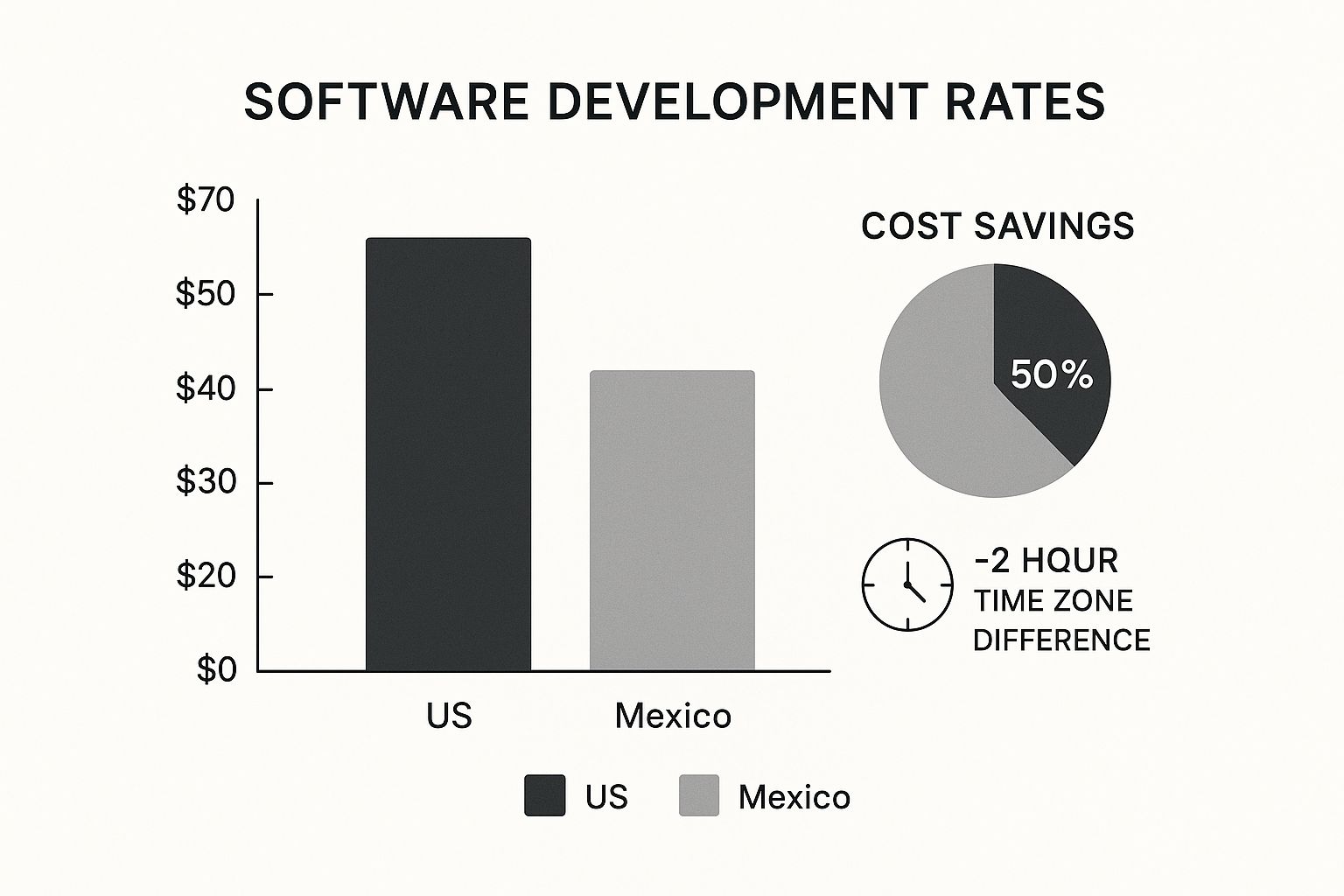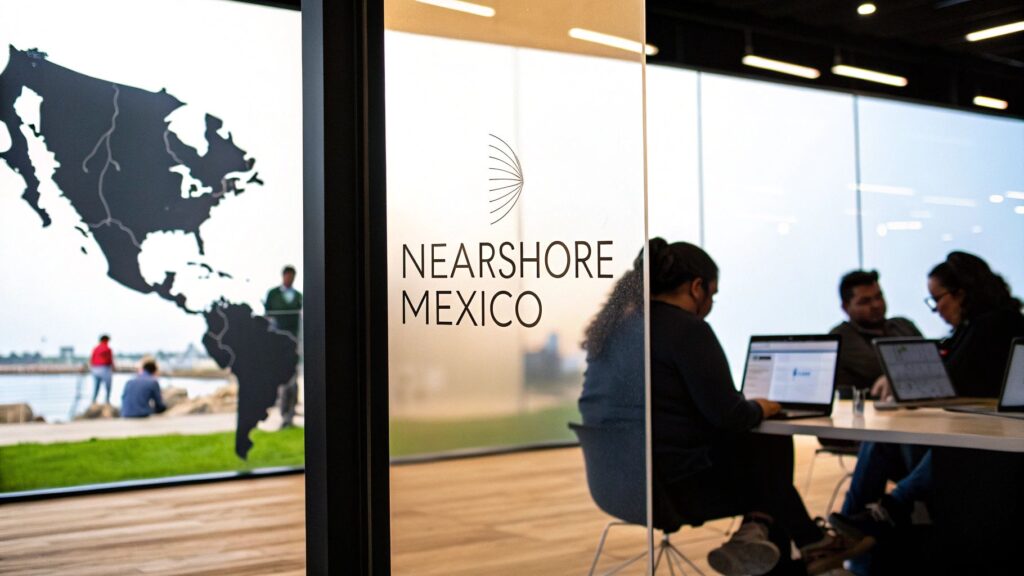Why Mexico Is Becoming the Nearshore Development Powerhouse

The software development industry is constantly evolving. Businesses continually seek the best balance of cost and quality. This search has fueled the growth of nearshore software development in Mexico, changing how companies manage their software projects. Mexico is quickly becoming the top choice for nearshore development. What’s driving this trend?
Real-Time Collaboration and Cultural Alignment
One major factor is the ease of real-time collaboration. Similar time zones minimize delays and facilitate seamless communication. This is a significant advantage over traditional offshore models, where large time differences can hinder progress. Shared cultural values and work ethics also contribute to a more cohesive and productive working relationship, leading to better project results. For more insights on the benefits of offshoring to Mexico, check out this article: Offshoring to Mexico: The Benefits Involved.
Efficiency and Performance
Geographic proximity also provides significant efficiency gains. Reduced travel costs and easier communication contribute to quicker problem-solving and faster turnaround times. Mexican development teams are consistently demonstrating strong performance on key delivery metrics, often outperforming teams in Asia and Eastern Europe. This highlights the high quality of talent available in Mexico. The growing number of companies, from startups to large enterprises, establishing development hubs in Mexico is a testament to this shift in the market.
The Economic Benefits of Nearshoring
Nearshoring to Mexico offers a compelling economic advantage, particularly for North American companies. It’s a way to reduce costs without sacrificing quality. In fact, 87% of IT businesses have considered nearshore outsourcing to cut costs, and 59% have already implemented it. This trend underscores the growing importance of optimizing expenses while maintaining high standards. Mexico’s expanding talent pool and positive business environment make it an attractive option. You can find more detailed statistics on nearshoring here. All these factors make a strong case for partnering with Mexico for nearshore development. The rise of nearshore development in Mexico represents a move towards more efficient, collaborative, and successful software development.
The True Economic Impact of Mexican Nearshoring
Beyond simply lower hourly rates, nearshoring software development to Mexico offers significant financial advantages that can reshape IT budgets. This section delves into the genuine savings achievable across various project types and company sizes, moving beyond basic hourly rate comparisons.
Salary Differentials: US vs. Mexico
A core component of cost savings lies in the salary differentials between US and Mexican developers. While specific figures vary based on specialization and experience, the cost difference can be substantial. For example, a senior full-stack developer in the US might command a significantly higher salary than a similarly skilled developer in Mexico. This difference becomes even more pronounced when considering specialized roles like AI and machine learning experts. These savings can be reinvested in other critical areas of your business.

The infographic above visualizes the average hourly rates for software developers in the US and Mexico, highlighting the potential cost savings and the convenient two-hour time difference. Leveraging Mexican nearshore talent allows companies to achieve considerable cost reductions while maintaining access to a highly skilled workforce within a manageable time zone.
Hidden Operational Efficiencies
The financial benefits extend beyond just salaries. Nearshoring introduces several operational efficiencies that often go unnoticed. Reduced travel expenses are a key factor. With Mexico’s proximity to the US, the cost of on-site visits and collaborative meetings decreases significantly compared to more distant offshore locations.
Additionally, improved communication due to minimal time zone differences minimizes rework cycles and streamlines project workflows, leading to further cost savings. This increased efficiency translates directly to a healthier bottom line for businesses.
Maximizing ROI and Mitigating Hidden Costs
While the cost advantages are clear, it’s crucial to approach nearshoring strategically to maximize ROI. Certain hidden costs, such as potential language barriers or cultural differences in work styles, need to be considered and addressed proactively.
Careful partner selection and clear communication protocols are essential for minimizing these challenges. Furthermore, building strong relationships with your nearshore team fosters a collaborative environment that drives project success and ultimately amplifies the return on your investment. By learning from companies that have successfully implemented nearshoring, businesses can effectively mitigate potential risks and realize the full financial benefits.
Calculating Your Potential Savings
Determining your specific savings potential requires a thorough assessment of your current development costs and projected needs. Factors like project complexity, team size, and required skill sets all play a role.
To understand potential savings, analyze these variables and compare them against the cost structure of a Mexican nearshore model. This should incorporate not just salary differentials, but also the quantifiable benefits of reduced travel, streamlined communication, and improved operational efficiencies. This comprehensive approach provides a clear picture of the potential financial impact.
To illustrate the potential cost savings, let’s consider a comparison table:
The table below, “Cost Comparison: US vs. Mexico Software Development”, provides a detailed comparison of costs between US-based and Mexico-based software development across different roles and experience levels. This comparison helps visualize the potential savings percentage.
| Role | Junior (US) | Junior (Mexico) | Senior (US) | Senior (Mexico) | Savings % |
|---|---|---|---|---|---|
| Project Manager | $100/hr | $50/hr | $150/hr | $75/hr | 50% |
| Software Developer | $80/hr | $40/hr | $120/hr | $60/hr | 50% |
| QA Tester | $60/hr | $30/hr | $90/hr | $45/hr | 50% |
| UI/UX Designer | $70/hr | $35/hr | $110/hr | $55/hr | 50% |
As the table demonstrates, engaging a nearshore team in Mexico can yield substantial savings across all roles, with a consistent 50% reduction in hourly rates compared to US-based counterparts. This significant cost difference allows businesses to allocate resources more effectively and potentially reinvest savings in other key areas.
Tapping Into Mexico’s Evolving Tech Talent Ecosystem
Mexico’s tech scene is rapidly becoming a significant player on the global stage, rivaling established tech hubs with a growing talent ecosystem. This growth isn’t just about quantity; it’s about the quality and specialization within Mexico’s developer community.
The Strength of Mexican Technical Expertise
Mexican developers possess a wide range of technical skills, excelling in areas like mobile and web development. Increasingly, they’re also making strides in niche areas like blockchain and machine learning. This specialized expertise is a key factor driving the growth of nearshore software development in Mexico. Many Mexican universities now offer dedicated programs in these emerging technologies, creating a pipeline of skilled graduates. Mexico’s IT workforce is also substantial, with over 723,000 software and multimedia developers and analysts, further bolstering the nearshore development sector. More detailed statistics are available here. This robust talent pool gives businesses a wide array of options when searching for specialized skills.

Regional Strengths and English Proficiency
Different regions within Mexico offer unique strengths. Guadalajara, for example, is a hub for embedded systems development, while Mexico City has a thriving fintech sector. The Mexican nearshoring market is proving beneficial for startup growth. Entrepreneurs in the fintech space might find the B2b Seo Agency For Fintech Startups a valuable resource. Recognizing these regional variations helps companies pinpoint the best locations for their projects. English proficiency is also strong in many Mexican development centers, facilitating seamless communication and collaboration with North American companies.
Building a Sustainable Talent Pipeline
Many companies are proactively partnering with Mexican technical universities. These partnerships go beyond simple recruitment, focusing on fostering long-term growth within the Mexican tech ecosystem. Through these collaborations, companies can influence curriculum development, sponsor research, and offer mentorship. This creates a sustainable talent pipeline of graduates aligned with current industry needs.
Government Initiatives and Skill Acceleration
The Mexican government is actively supporting the growth of its tech sector through various initiatives. These include promoting STEM education, funding tech startups, and attracting foreign investment in the technology industry. These efforts further solidify Mexico’s position as a nearshore development leader. This means the talent pool is not just large but also supported by a framework designed for continuous expansion and innovation. The combination of private and public investment creates a dynamic and promising environment for nearshore software development in Mexico.
Beyond Cost: Strategic Advantages That Transform Business

While cost savings are a major motivator for businesses exploring nearshore software development in Mexico, the real benefits go far beyond financial gains. Companies focused on the future are using these partnerships to achieve results that wouldn’t be possible with traditional in-house or offshore models.
Scaling for Growth and Seizing Opportunities
One of the most significant strategic advantages of nearshore software development in Mexico is the ability to quickly scale development capacity. This agility allows businesses to capitalize on market opportunities and adapt to changing demands with remarkable speed.
For example, a rapidly growing company can quickly expand its team with skilled Mexican developers, bypassing the long process of recruiting and onboarding in-house employees. This flexibility is essential in today’s competitive business environment.
Accessing Specialized Technical Expertise
Nearshoring also opens doors to specialized technical expertise that might be unavailable or prohibitively expensive domestically. Mexico has a burgeoning pool of developers skilled in a wide array of technologies. These include specialized areas like AI, machine learning, and blockchain.
This access to specialized skills allows companies to innovate and develop advanced products without the overhead of building and maintaining in-house expertise. For insights on attracting top talent, consider best practices for hiring remote software developers.
Accelerating Product Development Cycles
Partnering with a nearshore team in Mexico can significantly speed up product development cycles. The close proximity and aligned time zones allow for real-time collaboration and communication, minimizing delays and optimizing workflows.
This results in faster iteration and quicker time-to-market, providing a competitive edge. The USMCA agreement has also facilitated foreign investment and established free trade between Mexico and the USA, further strengthening the sector. Explore this further here.
Fostering Innovation Through Collaboration
Cultural alignment between US and Mexican teams plays a key role in fostering innovation. Shared values and a collaborative work ethic create a productive environment where ideas can thrive.
This synergy leads to more creative problem-solving and improved product outcomes. For more information, see the 8 Benefits of Hiring Latin American Remote Workers.
Building Operational Resilience
Geographic proximity contributes to operational resilience. Unlike offshore models where disruptions can be magnified by distance and time zone differences, nearshore partnerships offer greater stability.
This is particularly valuable during times of uncertainty, ensuring business continuity and mitigating potential interruptions. The close proximity allows for swift responses to unexpected challenges and strengthens the overall robustness of development operations.
This strategic advantage ensures businesses can adapt and maintain momentum even amidst change. By embracing nearshore software development in Mexico, businesses aren’t simply cutting costs; they are strategically positioning themselves for lasting success in the dynamic world of software development.
Inside Mexico’s Thriving Tech Hubs: Finding Your Perfect Match
Mexico’s tech scene isn’t a single entity. It’s a diverse collection of regional hubs, each with its own strengths. This closer look at Mexico’s tech centers goes beyond the obvious choices to reveal some hidden gems. You’ll discover specialized skills and advantages that general overviews often miss.
Beyond the Big Three: Exploring Emerging Tech Centers
Mexico City, Guadalajara, and Monterrey are established tech hubs. However, up-and-coming centers offer untapped talent and competitive edges. Cities like Querétaro, Aguascalientes, and Tijuana are quickly becoming known for their specialized skills and growing tech communities. Exploring these emerging hubs can open doors to unique opportunities, especially for businesses seeking specific expertise and a less competitive hiring environment.
Matching Your Needs to the Right Location
Each region in Mexico boasts its own technical specialties. Mexico City, for example, is a fintech powerhouse, attracting major financial institutions and nurturing a culture of innovation in financial technology. Guadalajara shines in embedded systems, drawing companies from the automotive and electronics sectors. Understanding these regional differences is essential for aligning your project needs with the perfect location. Mexico’s nearshore software development industry is booming, fueled by a skilled workforce and strategic location. This sector is expected to grow by 25% annually, making Mexico a prime destination for tech companies. Industry giants like Google, Microsoft, and Intel have established a presence in Mexico, attracted by the talent pool and robust IT infrastructure. Learn more about software development in Mexico here. This continued growth reinforces Mexico’s position as a leader in the nearshore landscape.
To help you better understand the varied landscape of Mexican tech, let’s take a look at the following table summarizing the key hubs and their specializations.
Mexico’s Major Tech Hubs and Specializations: An overview of Mexico’s primary technology centers, their specializations, and key characteristics.
| City | Key Industries | Tech Specializations | University Presence | Notable Companies |
|---|---|---|---|---|
| Mexico City | Fintech, E-commerce | AI, Machine Learning, Mobile Dev | UNAM, ITAM, IPN | Google, Amazon |
| Guadalajara | Automotive, Electronics | Embedded Systems, Software Engineering | ITESO, Universidad de Guadalajara | Intel, IBM |
| Monterrey | Manufacturing, Logistics | Cloud Computing, Cybersecurity | Tec de Monterrey, UANL | Microsoft, Oracle |
| Querétaro | Aerospace, Automotive | Data Science, IoT | UAQ, ITQ | Airbus, Bombardier |
| Aguascalientes | Automotive, Manufacturing | Robotics, Automation | UAA | Nissan, Jatco |
| Tijuana | Medical Devices, Electronics | Software Testing, QA | UABC, CETYS Universidad | Thermo Fisher, Medtronic |
This table offers a solid starting point for navigating Mexico’s tech hub diversity. Many regions are developing niche expertise in emerging technologies beyond these listed specializations, further expanding the possibilities for nearshore partners.
Regional Variations: Salaries, Retention, and Competition
Technical skills aren’t the only factors to consider. Regional differences in salaries, employee retention, and competition for talent can significantly influence your recruitment efforts. Guadalajara, known for its strong engineering universities, benefits from high retention rates. Mexico City’s competitive market, however, may lead to higher salaries. Factoring in these regional nuances enables informed decisions about talent acquisition and project budgets. A thorough understanding of Mexico’s regional tech ecosystems is key to unlocking the full potential of your nearshore software development partnership. By carefully weighing these factors, businesses can strategically position themselves for success in this dynamic market.
Building Your Nearshore Strategy: From Selection to Success
Nearshore software development in Mexico presents significant opportunities for businesses seeking to expand their development capabilities. However, realizing these opportunities requires a carefully crafted strategy. This section offers a practical framework, informed by the experiences of companies that have successfully established development operations in Mexico.
Evaluating Potential Partners
Choosing the right partner is crucial for nearshore success. Start by defining clear objectives for your nearshore initiative. What specific business challenges are you trying to solve? What technical skills are essential for your project? Once you have these goals in mind, you can create a robust evaluation process.
- Define key criteria: Consider factors like technical expertise, communication effectiveness, cultural alignment, and security protocols.
- Develop a scorecard: A weighted scoring system allows for objective assessment of potential partners.
- Conduct thorough interviews: Go beyond the basics and delve into their development methodologies, project management practices, and relevant industry experience.
This rigorous evaluation process ensures you choose a partner that aligns with your long-term business goals.
Structuring Agreements and Fostering Relationships
A well-structured contract protects your interests and promotes collaboration. Clearly define project scopes, deliverables, and payment terms. Thoroughly address intellectual property protection and data security. But a truly successful partnership goes beyond the legal framework. It’s essential to cultivate open communication and build trust.
- Regular communication: Schedule regular check-in meetings to discuss progress, address any roadblocks, and ensure everyone is on the same page.
- Relationship building: Foster strong professional relationships with your nearshore team to create a collaborative and productive environment.
Choosing the Right Engagement Model
Different projects require different engagement models. A dedicated team provides long-term stability and deep integration, which is ideal for ongoing development. Project-based engagements are well-suited for defined projects with clear timelines. Hybrid approaches combine elements of both models for greater flexibility.
The right choice depends on your specific project needs and long-term objectives. Consider the scope of work, your internal resources, and the desired level of control.
Communication and Knowledge Transfer
Effective communication is fundamental to successful nearshore collaboration. Implement clear communication protocols using tools like Slack and project management platforms. Establish a knowledge transfer process to preserve intellectual capital. This could involve detailed documentation, training sessions, or regular knowledge-sharing meetings. Mexico’s proximity to the US and favorable time zones facilitate seamless communication and collaboration with North American companies. Furthermore, Mexico’s growing fintech and AI sectors, with fintech experiencing 18.4% growth in recent years, demonstrate the country’s increasing potential in nearshore software development. Discover more insights about nearshoring in Mexico here.
Measuring Success and Continuous Improvement
Define clear performance metrics to track the success of your nearshore initiative. Monitor key indicators such as on-time delivery, budget adherence, and code quality. Regularly review performance, identify areas for improvement, and adapt your strategy as needed. This iterative process ensures your nearshore partnership consistently delivers business value.
Building a successful nearshore strategy is an ongoing process. By following these guidelines, you can maximize the benefits of nearshore software development in Mexico and achieve your business objectives. Looking to transform your software development with a nearshore team in Latin America? Explore the possibilities with Nearshore Business Solutions.
